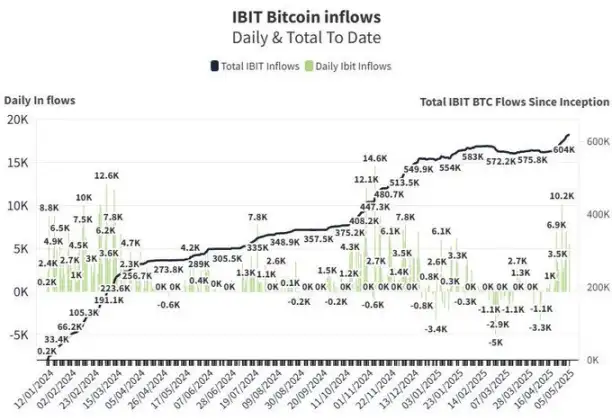On the morning of May 7, the cryptocurrency market rebounded from the consecutive declines after the May Day holiday, with the secondary market following BTC's rise. BTC rose from its previous low of $93,390 to $97,732, an increase of over 4.4%, recovering the decline of the past five days. At the time of writing, Bitcoin was trading at $96,866.
VX: TZ7971
ETH recovered from $1,751.45 to $1,850, a 5.6% increase. SOL rose from $141.41, reaching a high of $149.54, a 5.74% increase.
The total cryptocurrency market value rebounded by over 2%, once again breaking through $3 trillion. Bitcoin's market dominance exceeded 65%, reaching a new high since January 2021. The Fear and Greed Index rose to 67, indicating greed. Meanwhile, US crypto stocks also rose after hours, with Coinbase recovering to $200, up 1.58%, and MicroStrategy closing at $393.89, up over 2.15%.
What catalyzed the sharp rise in crypto and global risk assets in the early market?
On the morning of May 7, news of talks between China and the US significantly boosted risk appetite, with the RMB rising over 100 points and breaking 7.20. The three major US stock indices surged, with Nasdaq futures rising over 1%. Spot gold fell over 1.9%, hitting a daily low of $3,370 per ounce.

Tariff Pressure Becomes Unsustainable
The subtle turn in China-US relations became a key turning point for market sentiment. This is the first face-to-face consultation on trade issues between high-level officials since the 2024 G20 Summit, interpreted by the market as a clear signal of "pausing tariff escalation".
Historical data shows that during the China-US trade negotiation window in January 2024, Bitcoin rose 22% in a single month due to improved cross-border capital flow expectations. In the 48 hours before this news, the crypto market had already digested the tariff suppression sentiment - when US stocks plummeted on May 6, BTC only fell 0.3%, significantly lower than Nasdaq's 0.87% decline, demonstrating its "desensitization" to geopolitical risks.
The US trade deficit surged to $123.4 billion in March, the highest since 1992, mainly due to companies stockpiling imported goods before tariffs take effect. This data forced Trump to re-evaluate the effectiveness of the "tariff pressure" strategy.
Maintaining current tariff rates would reduce US retailers' annual profits by 15% and potentially push inflation back to 5.5%. "The marginal improvement in tariff policy is essentially a global capital re-pricing of 'de-dollarization' assets." When US dollar credit is damaged by trade conflicts, BTC's "digital neutrality" becomes the optimal solution for cross-border value storage.
Institutional "Regular Investing" and Policy Support
While the market is immersed in the short-term benefits of China-US easing, institutions seem to have long been reshaping the crypto valuation system through "BTC regular investing". On May 6, BTC spot ETF had a net inflow of $425 million, with total net asset value reaching $110.685 billion, and the ETF net asset ratio (market value to total market cap) reaching 5.91%, with cumulative net inflow of $40.662 billion.
BlackRock's BTC spot ETF (iShares Bitcoin Trust ETF) purchased 5,613 BTC again, worth about $529.5 million, currently holding 620,252 BTC valued at about $58.51 billion. Since April 21, BlackRock has accumulated 47,064 BTC, worth about $4.44 billion. Moreover, in the past week, BlackRock's ETF has had a daily directional inflow of $500 million, sparking market speculation about "high-position adding".

Positive news came from US state-level crypto strategic reserves. New Hampshire is the first state to pass a bill treating cryptocurrency as a strategic reserve. This represents the state treasurer investing up to 5% of state government funds in precious metals and cryptocurrencies with a market cap of at least $50 billion.
With New Hampshire's total budget of $15.4 billion, 5% is about $770 million; with a general fund of $5.6 billion, 5% is about $280 million. Therefore, the state's potential crypto investment ranges from $280 million to $770 million, setting a flag for subsequent state legislative crypto strategic reserves.
Fed Meeting Still Deeply Buried "Fuse"
Despite short-term sentiment recovery, the Fed's May rate decision still hangs like the "Sword of Damocles". CME rate futures show the current market sees only a 3.1% probability of a 25 basis point rate cut in May. The probability of a 25 basis point cut in June is also only 65% (down 10 percentage points from the April peak), with the 10-year US Treasury yield accelerating to 3.75%, reflecting investor concerns about "policy lag" - April non-farm employment added 177,000 jobs, and the core PCE price index rose 4.7% year-on-year, indicating the US economy's resilience and potentially delaying the rate cut.
The crypto market faces a delicate balance. If the Fed maintains rates unchanged, high funding costs may suppress risk asset valuations (historical data shows that for each percentage point rates are maintained, Bitcoin's implied volatility will increase by 12%); if a dovish signal is released, BTC's logic as an "anti-inflation asset" will be quickly reinforced.
The current market's point of contention is the Fed's "rate cut pace". In the Fed's latest "Economic Projection Summary", 12 officials support only a 50 basis point cut in 2025, while 7 support a 100 basis point cut, forming a rare "hawk-dove confrontation".
As the traditional financial system falls into "stagflation spiral" (stubborn inflation + slowing growth), Bitcoin's network effect (daily active addresses reaching 12 million) and market cap (over $1.9 trillion) make it a "necessity" for institutions to hedge policy risks.
It's worth noting that the Fed's overnight reverse repo scale has continuously decreased to $1.2 trillion for three consecutive days, indicating an easing of bank system liquidity surplus, which may indirectly affect the scale of crypto leverage funds.
However, although BTC has recovered above the $97,000 mark, its dominance exceeding 65% shows strong risk-averse sentiment. Combined with BTC's recent extremely low volatility, significant price fluctuations may occur after the Fed meeting. Whether Powell "hawks" or "doves" this time will be crucial.






